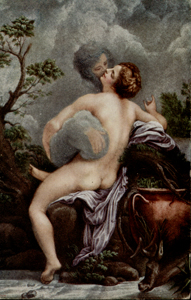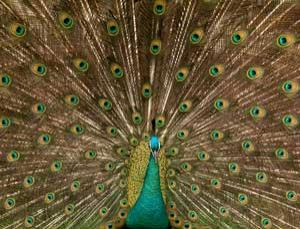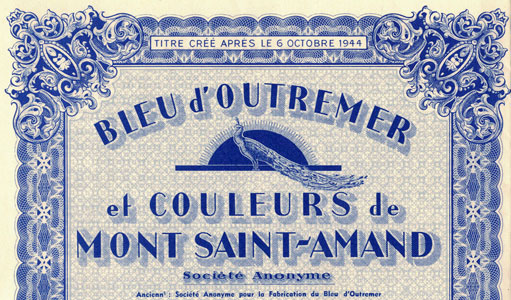
Dr. Hugo H. van der Molen - Wederikweg
114 - 9753 AE Haren, The Netherlands
Tel: +31 (0)50 534 8795; email:
[email protected]
Follow@plattezaken en Facebook of Linkedin
Hermes is sometimes called Argeëphontes or Argofonias, i.e.the murderer of Argus. The underlying story is the following (source: Souli, 1995, p. 40).

In Argos lived Inachus' most famous daughter Io, a beautiful girl who
became a priestess of Hera and attracted the amorous attention of Zeus
himself. Zeus, although being married to Hera, seduced many a beautiful woman, often in disguise (methamorphosis). In the diguise of a cloud, he seduced Io as is depicted in a painting by Correggio.

Zeus, in disguise of a cloud, seduces Io
His wife Hera, seeing them in each others arms, flew into a rage with Io and turned her into a cow. Then she tied the cow to an olive-tree in the sacred grove of Mycenae and set Argus the All-seeing, of the line of Phoroneus - a beast with eyes all over his body and tremendous strength - to keep watch on it (we still have the expression to watch Argus-eyed; NL: kijken met Argusogen). But Zeus set Hermes to steal Io, which he did by lulling Argus to sleep with the music of his pipes. But no sooner was this done than Hera sent a gadfly (NL: horzel) to persecute the unfortunate Io whom it caused to run madly from one country to another. After crossing the Ionian sea (and thus giving it its name), Io wandered through Illyria, Aenus, the Bosporus (= "ox-crossing" / NL: koeieneweg), the Crimea and Asia, coming ultimately to Egypt and resuming human form. There she maried king Telegonus and, after her death, was worshipped as a goddess under the name Isis. (source: Mavromataki, 1997, p. 213,214 and Hull, 1993, p. 173/4).
Hall (1993, p. 236) gives a somewhat different story, based on Ovidius'
Metamorphoses I: 588-600; 639-663 and I: 668-721. (Image: Tom Chance / WestEnd61/Rex Features) |
 |
In art Argus is usually depicted as a muscled shepherd with 2 eyes only. Hermes plays a sheperd's flute or approaches with a sward. Io stands quietly grazing. Sometimes Hermes places a foot on a cut off head, referring to this episode.
In the famous painting Mercurio y Argo from the Spanish painter Velasquez, (depicted on a share from the Spanish Banco de Cartagena; see below) Io is lying down, the muscled sheperd is sleeping and Hermes slinks towards his prey, drawing his sword.
Historic share for sale:
Banco de Cartagena
Cartagena, Spain, 1900; Accion al
Portador De Quinientas Pesetas (bearer share of 50 (?) Pesetas);
Print by Arnoud - Lyon / Paris; 20
by 10 cm black engraving of the famous painting Mercurio y Argo (Mercury
and Argus) by D. Velasquez (1599-1660); VF+: one faint middle fold
with a 1 cm tear in left border (on the fold, but hardly visible; a few
small wrinkles in left upper border); price 125 Euro.
order here.
The picture shows the god Hermes (L: Mercury) drawing his sword
in order to decapitate the shepard who guarded princes Io, who had been
transformed into a white cow by Zeus (L: Jupiter).
When Velasquez was commissioned to do the interior decoration of
the famous Alcazar palace, he made 4 paintings with mythological subjects.
Only this painting was preserved, now hanging in the Prado museum in Madrid.
Historic picture post card for sale:
 |
uitg. J. Plichta, Prague I-321; .P.P/1061
orderno. mythologie 5 ; order here |
Hall (1993), Hall's Iconografisch Handbook, Onderwerpen, symbolen en
motieven in de beeldende kunst, transalated by Theo Veenhof, Leiden, The
Netherlands: Primavera pers. ISBN: 90-74310-05-2
(Original title: Dictionary of Subjects and Symbols in Art, published
by John Murray in London)
Mavromataki, M. (1997), Greek Mythology and Religion, Athens: Haitalis, Astrous street 13, 13121 Athens, (tel: +32 (01)5766.883). This is a beautifully illustrated book, strongly recommended for reading. (256 pages).
Souli, S. (1995), Griekse Mythologie, Athens: Michalis Toubis
(Vouliagmenis Avenue 519, Ilioupolis 16341. Tel: +32 (01) 992 3876). Web:
http//www.toubis.gr.
This is a beautifully illustrated book, strongly recommended for reading.
ISBN: 960-7504-27-5 (175 pages).
See also old stocks illustrated with peacocks:

You are here: home - scripophily - search by illustration - mythology - Hermes & Argus
Follow@plattezaken en Facebook of Linkedin
See also our large and beautiful collections of |
Bekijk ook onze grote en fraaie collecties kunst, mooie vrouwen, mythologie en zeer decoratieve effecten |